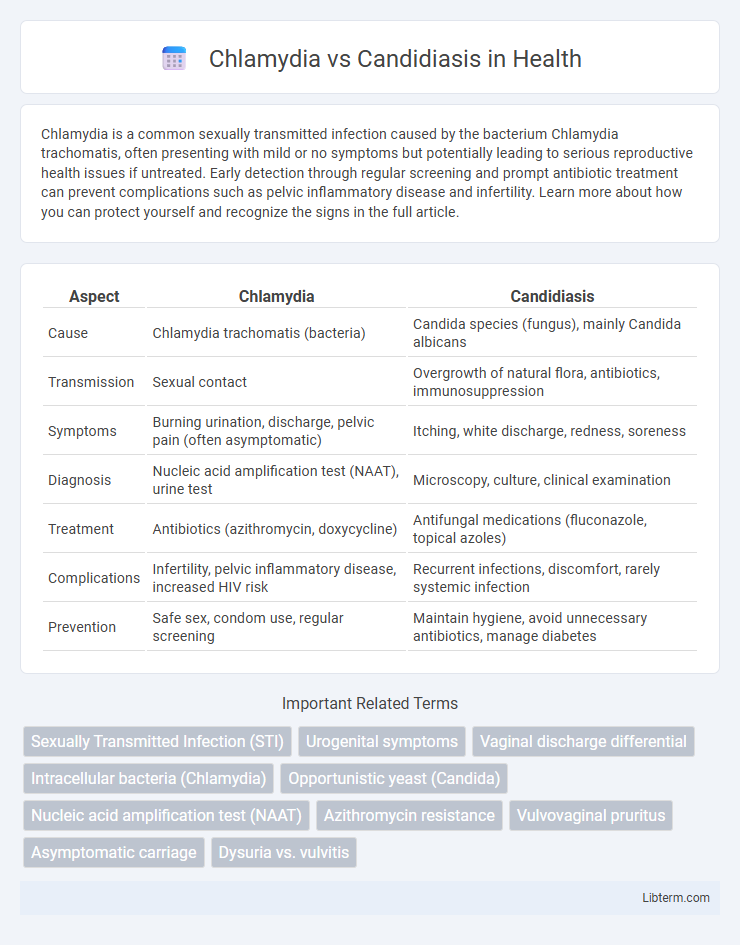Chlamydia is a common sexually transmitted infection caused by the bacterium Chlamydia trachomatis, often presenting with mild or no symptoms but potentially leading to serious reproductive health issues if untreated. Early detection through regular screening and prompt antibiotic treatment can prevent complications such as pelvic inflammatory disease and infertility. Learn more about how you can protect yourself and recognize the signs in the full article.
Table of Comparison
| Aspect | Chlamydia | Candidiasis |
|---|---|---|
| Cause | Chlamydia trachomatis (bacteria) | Candida species (fungus), mainly Candida albicans |
| Transmission | Sexual contact | Overgrowth of natural flora, antibiotics, immunosuppression |
| Symptoms | Burning urination, discharge, pelvic pain (often asymptomatic) | Itching, white discharge, redness, soreness |
| Diagnosis | Nucleic acid amplification test (NAAT), urine test | Microscopy, culture, clinical examination |
| Treatment | Antibiotics (azithromycin, doxycycline) | Antifungal medications (fluconazole, topical azoles) |
| Complications | Infertility, pelvic inflammatory disease, increased HIV risk | Recurrent infections, discomfort, rarely systemic infection |
| Prevention | Safe sex, condom use, regular screening | Maintain hygiene, avoid unnecessary antibiotics, manage diabetes |
Understanding Chlamydia and Candidiasis
Chlamydia is a common sexually transmitted infection caused by the bacterium Chlamydia trachomatis, typically affecting the genital tract and often remaining asymptomatic in many individuals. Candidiasis, also known as a yeast infection, results from an overgrowth of the fungus Candida, primarily Candida albicans, affecting areas such as the mouth, throat, or genitals. Understanding the distinct microbial origins and symptoms of chlamydia and candidiasis is crucial for accurate diagnosis and targeted treatment strategies.
Causes and Risk Factors
Chlamydia is caused by the bacterium Chlamydia trachomatis, primarily transmitted through unprotected sexual contact, with risk factors including multiple sexual partners, young age, and inconsistent condom use. Candidiasis results from an overgrowth of Candida species, particularly Candida albicans, often triggered by factors such as antibiotic use, diabetes, immunosuppression, and hormonal changes like pregnancy. Both infections are influenced by compromised immune defenses and behaviors that disrupt normal microbial balance or increase exposure to pathogens.
Modes of Transmission
Chlamydia primarily spreads through unprotected sexual contact, including vaginal, anal, or oral sex, and can also be transmitted from mother to child during childbirth. Candidiasis, caused by the overgrowth of Candida fungi, is typically transmitted through direct skin-to-skin contact, sharing of contaminated items, or disruption of normal flora due to antibiotics or immune suppression. Understanding these distinct transmission modes is crucial for effective prevention and control strategies.
Key Symptoms and Signs
Chlamydia primarily presents with symptoms such as painful urination, abnormal genital discharge, and pelvic pain, often accompanied by swelling or soreness in the affected areas. Candidiasis manifests through intense itching, thick white vaginal or oral discharge, redness, and irritation around the genital or mouth region. Both infections can be asymptomatic but recognizing these distinctive signs is crucial for accurate diagnosis and treatment.
Diagnosis: Tests and Evaluations
Chlamydia diagnosis typically involves nucleic acid amplification tests (NAATs) due to their high sensitivity and specificity, using urine samples or swabs from the cervix, urethra, or rectum. Candidiasis diagnosis relies on microscopic examination of vaginal or oral swabs with potassium hydroxide (KOH) preparation, culture tests, and clinical evaluation of symptoms like itching and discharge. Both infections may require patient history and symptom assessment to guide appropriate testing and ensure accurate identification.
Treatment Options and Medications
Chlamydia treatment generally involves a prescribed course of antibiotics such as azithromycin or doxycycline, aiming to eliminate the bacterial infection efficiently within 7 to 14 days. Candidiasis, caused by Candida yeast, is commonly treated with antifungal medications like fluconazole or topical clotrimazole, which target fungal cells to restore normal vaginal flora. Both conditions require timely medical intervention to prevent complications, with chlamydia demanding strict adherence to antibiotic therapy to avoid antibiotic resistance, while candidiasis treatment focuses on reducing fungal overgrowth and preventing recurrence.
Complications and Long-Term Effects
Chlamydia, a bacterial infection, can lead to serious complications such as pelvic inflammatory disease (PID), infertility, ectopic pregnancy, and increased risk of HIV transmission if untreated. Candidiasis, caused by Candida yeast overgrowth, may result in recurrent infections, chronic mucocutaneous candidiasis, and systemic candidiasis in immunocompromised individuals. Long-term effects of untreated chlamydia pose higher risks for reproductive health issues compared to candidiasis, which primarily affects mucosal and skin barriers unless systemic dissemination occurs.
Prevention Strategies
Prevention strategies for Chlamydia focus on consistent and correct condom use, regular sexual health screenings, and limiting the number of sexual partners to reduce transmission risk. For Candidiasis, maintaining proper genital hygiene, avoiding excessive use of antibiotics that disrupt normal flora, and keeping the affected area dry and breathable are critical preventive measures. Both infections benefit from education on sexual health and prompt treatment of symptoms to prevent complications and further spread.
Differences in Male and Female Presentations
Chlamydia in males commonly presents with urethritis, characterized by dysuria and penile discharge, while in females, it often causes cervicitis with abnormal vaginal discharge and pelvic pain. Candidiasis manifests in males as balanitis or balanoposthitis, presenting with redness, itching, and white patches on the glans, whereas females typically experience vulvovaginal candidiasis marked by itching, erythema, and thick white vaginal discharge. Diagnostic approaches and symptomatic variations necessitate gender-specific treatment strategies for effective management of both infections.
When to Seek Medical Attention
Seek medical attention immediately if you experience abnormal genital discharge, persistent pain, or burning during urination, as these symptoms can indicate Chlamydia, a common sexually transmitted infection caused by the bacterium Chlamydia trachomatis. For symptoms such as intense vaginal itching, white curd-like discharge, and redness or swelling, indicative of Candidiasis caused by the fungus Candida albicans, prompt evaluation is necessary to prevent complications. Early diagnosis and treatment for both infections reduce the risk of long-term reproductive health issues and transmission to sexual partners.
Chlamydia Infographic

 libterm.com
libterm.com